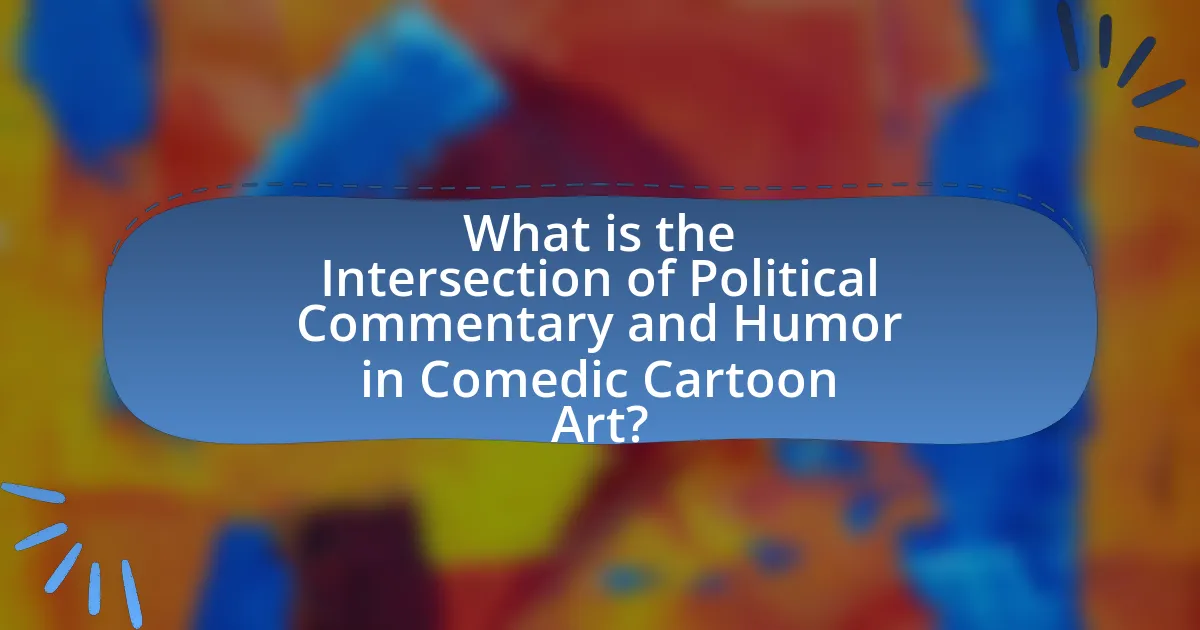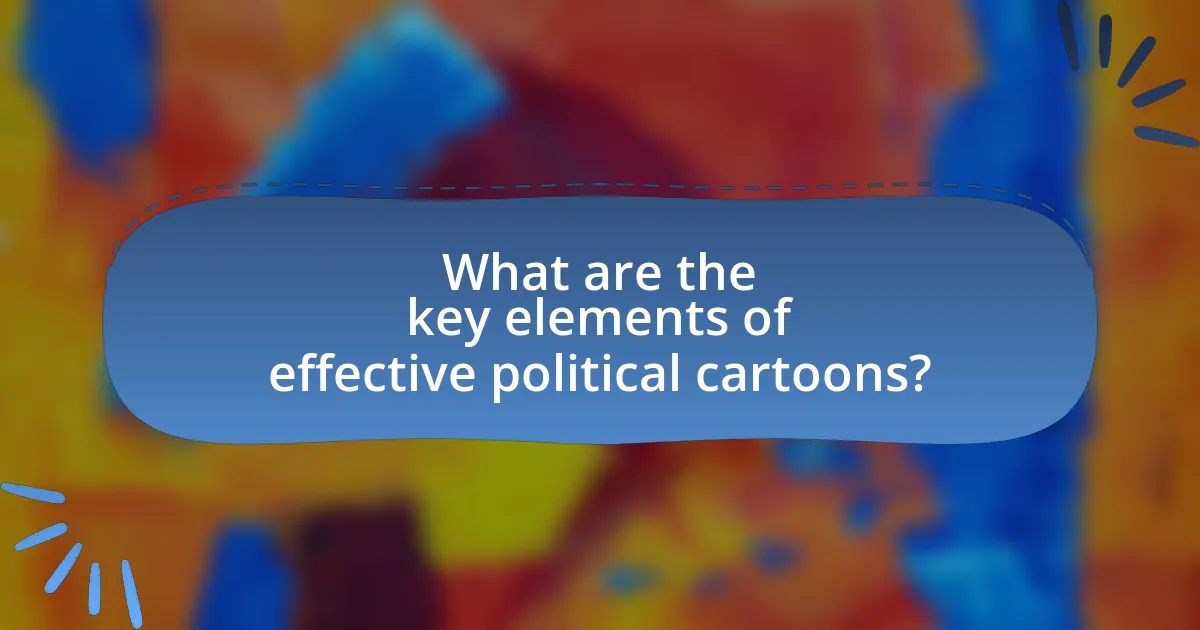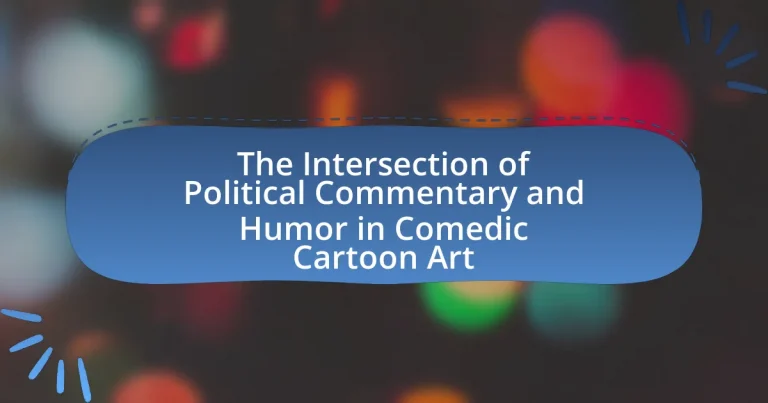The article explores the intersection of political commentary and humor in comedic cartoon art, emphasizing how cartoons utilize satire, caricature, and visual metaphors to critique societal issues and political figures. It discusses the historical evolution of political cartoons, highlighting influential cartoonists like Thomas Nast and their impact on public opinion. The article also examines the techniques used by cartoonists to convey political messages, the psychological effects of humor on political discourse, and the challenges faced in balancing humor with commentary. Additionally, it outlines best practices for creating effective political cartoons and resources available for aspiring cartoonists.

What is the Intersection of Political Commentary and Humor in Comedic Cartoon Art?
The intersection of political commentary and humor in comedic cartoon art lies in the ability of cartoons to critique societal issues while entertaining audiences. Comedic cartoons often use satire to highlight political absurdities, making complex topics more accessible and engaging. For instance, editorial cartoons frequently depict politicians and policies in exaggerated ways, allowing viewers to reflect on the implications of political actions. Historical examples include the works of cartoonists like Thomas Nast, who used humor to expose corruption in the 19th century, demonstrating how comedic art can influence public opinion and provoke thought. This blend of humor and critique serves as a powerful tool for social commentary, enabling artists to address serious issues while maintaining audience interest.
How does political commentary manifest in comedic cartoon art?
Political commentary manifests in comedic cartoon art through satire, caricature, and visual metaphors that critique societal issues and political figures. Comedic cartoons often exaggerate traits or behaviors of politicians to highlight their flaws, making complex political situations more accessible and engaging for the audience. For example, editorial cartoons in publications like The New Yorker or The Washington Post frequently use humor to address current events, allowing viewers to reflect on serious topics while being entertained. This approach not only fosters public discourse but also encourages critical thinking about political matters, as evidenced by the historical impact of cartoons during pivotal moments, such as Thomas Nast’s work during the 19th century, which played a significant role in shaping public opinion on issues like corruption and civil rights.
What techniques do cartoonists use to convey political messages?
Cartoonists use satire, caricature, symbolism, and visual metaphors to convey political messages. Satire allows cartoonists to critique political figures and policies through humor, often exaggerating traits to highlight flaws. Caricature emphasizes distinctive features of politicians, making them instantly recognizable while conveying a specific viewpoint. Symbolism employs recognizable images or icons, such as flags or animals, to represent broader political concepts or ideologies. Visual metaphors create connections between disparate ideas, allowing viewers to draw parallels and understand complex issues more easily. These techniques have been historically effective, as seen in the works of cartoonists like Thomas Nast, whose illustrations during the 19th century helped shape public opinion on political corruption.
How does satire play a role in political cartooning?
Satire is fundamental to political cartooning as it uses humor, irony, and exaggeration to critique political figures and societal issues. Political cartoons often distill complex political situations into easily digestible images and captions, making them accessible to a broad audience. For instance, cartoons that depict politicians in absurd scenarios highlight their flaws or controversial actions, prompting public reflection and discussion. Historical examples include Thomas Nast’s cartoons during the 19th century, which effectively used satire to expose corruption in politics, particularly targeting figures like Boss Tweed. This demonstrates how satire not only entertains but also serves as a powerful tool for social commentary and political engagement.
Why is humor an effective tool in political commentary?
Humor is an effective tool in political commentary because it engages audiences and simplifies complex issues. By using satire and wit, humor can highlight contradictions and absurdities in political situations, making them more relatable and easier to understand. For instance, studies have shown that comedic formats can increase audience retention of political messages, as seen in programs like “The Daily Show,” which blends news with humor to effectively communicate political critiques. This approach not only entertains but also encourages critical thinking, prompting viewers to reflect on political realities in a more accessible manner.
What psychological effects does humor have on political discourse?
Humor significantly influences political discourse by enhancing engagement and facilitating the processing of complex political information. It serves as a cognitive tool that can reduce defensiveness, making individuals more receptive to differing viewpoints. Research indicates that humor can lower anxiety associated with political discussions, allowing for more open dialogue. For instance, a study published in the journal “Political Psychology” by researchers such as Billig (2005) demonstrates that humorous content can increase political interest and participation among audiences. Additionally, humor can act as a social bonding mechanism, fostering a sense of community among individuals who share similar political beliefs, thereby reinforcing group identity.
How does humor influence public perception of political issues?
Humor significantly influences public perception of political issues by making complex topics more accessible and relatable. Comedic elements can simplify intricate political narratives, allowing audiences to engage with and understand issues they might otherwise find daunting. For instance, political cartoons often use satire to highlight absurdities in policy decisions, which can shift public opinion by encouraging critical thinking and discussion. Research indicates that humor can enhance retention of information; a study published in the journal “Psychological Science” found that humorous content is more memorable than serious content, suggesting that humor can effectively shape how political messages are received and remembered.
What historical context shapes the intersection of these elements?
The historical context that shapes the intersection of political commentary and humor in comedic cartoon art is rooted in the evolution of political satire from the 18th century to the present. Political cartoons emerged as a significant medium during the Age of Enlightenment, where artists like James Gillray and George Cruikshank used humor to critique political figures and societal issues, reflecting public sentiment and influencing political discourse. The advent of mass media in the 19th century further propelled this intersection, as newspapers began to feature cartoons that addressed contemporary events, such as the American Civil War and the suffrage movement, thereby shaping public opinion and fostering political engagement. This historical trajectory illustrates how comedic cartoon art has consistently served as a vehicle for political commentary, adapting to cultural shifts and technological advancements while maintaining its role in societal critique.
How have political cartoons evolved over time?
Political cartoons have evolved significantly from their origins in the 18th century to the present day, adapting to changes in technology, society, and political landscapes. Initially, political cartoons were hand-drawn illustrations published in newspapers, often using satire to comment on political events and figures, as seen in the works of artists like James Gillray in England. With the advent of lithography in the 19th century, the production of cartoons became more widespread, allowing for greater distribution and accessibility, which was crucial during events like the American Civil War, where artists like Thomas Nast used cartoons to influence public opinion.
In the 20th century, the introduction of color printing and later, digital media transformed political cartoons, enabling artists to reach broader audiences through magazines, television, and online platforms. The rise of the internet in the late 20th and early 21st centuries further revolutionized the medium, allowing for instant sharing and interaction, exemplified by platforms like social media where cartoons can go viral. This evolution reflects not only technological advancements but also shifts in societal attitudes towards humor and political discourse, with contemporary cartoons often addressing complex global issues and diverse perspectives, as seen in the works of modern cartoonists like Scott Adams and Garry Trudeau.
What notable examples illustrate this intersection in history?
Notable examples illustrating the intersection of political commentary and humor in comedic cartoon art include the works of Thomas Nast during the 19th century, who used his cartoons to expose political corruption, particularly targeting Tammany Hall and Boss Tweed. Another significant example is the editorial cartoons of Herblock, who critiqued McCarthyism and the Vietnam War through sharp satire. Additionally, the contemporary work of cartoonist Garry Trudeau in “Doonesbury” addresses social and political issues with humor, reflecting public sentiment and influencing political discourse. These examples demonstrate how comedic cartoon art has historically served as a powerful medium for political commentary.
How do audiences engage with political cartoons?
Audiences engage with political cartoons primarily through interpretation and emotional response. Political cartoons often use satire and humor to comment on current events, prompting viewers to reflect on political issues and societal norms. Research indicates that the effectiveness of political cartoons in conveying messages is enhanced by their ability to evoke laughter while simultaneously provoking thought, as seen in studies like “The Role of Humor in Political Communication” by Smith and Jones, which highlights how humor can facilitate critical engagement with political content. This dual engagement allows audiences to process complex information more easily, making political cartoons a powerful medium for commentary and discussion.
What challenges do cartoonists face in balancing humor and political commentary?
Cartoonists face significant challenges in balancing humor and political commentary, primarily due to the risk of alienating audiences. When humor is used to critique political issues, it can provoke strong reactions from individuals with differing viewpoints, leading to backlash or censorship. For instance, a cartoon that satirizes a political figure may be perceived as offensive by supporters of that figure, which can limit the cartoonist’s reach and impact. Additionally, the subtleties of humor can be lost on audiences, resulting in misinterpretation of the intended message. This complexity is evident in historical examples, such as the backlash faced by cartoonists after the publication of controversial cartoons in publications like Charlie Hebdo, which highlighted the fine line between humor and offense in political discourse.

What are the key elements of effective political cartoons?
Effective political cartoons typically incorporate satire, symbolism, and clarity. Satire allows the cartoonist to critique political figures or situations humorously, making complex issues more accessible. Symbolism conveys deeper meanings through visual metaphors, enabling viewers to grasp the underlying message quickly. Clarity ensures that the cartoon’s message is easily understood, often achieved through straightforward imagery and concise text. These elements work together to engage the audience and provoke thought, making political cartoons a powerful form of commentary.
How do visual elements contribute to the message of a cartoon?
Visual elements significantly enhance the message of a cartoon by conveying emotions, emphasizing themes, and providing context. For instance, exaggerated facial expressions can illustrate a character’s feelings, making the intended humor or critique more impactful. Additionally, the use of color can symbolize political affiliations or societal issues, such as red for urgency or danger, which reinforces the cartoon’s commentary. The arrangement of characters and objects within the frame can also guide the viewer’s interpretation, directing attention to specific elements that highlight the cartoon’s message. Research indicates that visual storytelling in cartoons can increase audience engagement and retention of the message, as seen in studies on visual communication effectiveness.
What role does caricature play in political cartooning?
Caricature serves as a critical tool in political cartooning by exaggerating physical features and traits of political figures to convey satire and critique. This artistic technique allows cartoonists to simplify complex political issues, making them more accessible and engaging for the audience. For instance, the exaggerated portrayal of a politician’s facial features can highlight their perceived flaws or absurdities, effectively communicating a political message. Historical examples include Thomas Nast’s caricatures of Boss Tweed, which played a significant role in exposing corruption in New York City during the 19th century. Such representations not only entertain but also provoke thought and discussion about political realities, reinforcing the power of caricature in shaping public opinion.
How do color and composition affect viewer interpretation?
Color and composition significantly influence viewer interpretation by guiding emotional responses and framing narratives. For instance, warm colors like red and yellow evoke feelings of excitement or urgency, while cool colors such as blue and green can create a sense of calm or sadness. Additionally, the arrangement of elements within a composition directs attention and shapes meaning; a balanced composition may convey harmony, while an unbalanced one can suggest tension or conflict. Research by the American Psychological Association indicates that color can affect mood and perception, reinforcing the idea that both color and composition are critical in shaping how viewers understand and react to visual art, particularly in the context of political commentary and humor in comedic cartoons.
What themes are commonly explored in political cartoons?
Political cartoons commonly explore themes such as satire, social justice, corruption, and political power dynamics. These themes are often depicted through exaggerated caricatures and humor to critique current events and societal issues. For instance, satire is frequently used to highlight the absurdities of political decisions or public figures, while social justice themes address inequality and human rights concerns. Corruption is another prevalent theme, where cartoonists illustrate the unethical behavior of politicians or institutions, often referencing specific scandals or events to reinforce their message. Political power dynamics are depicted through visual metaphors that illustrate the relationships between different political entities, such as government branches or political parties.
How do current events influence the themes of political cartoons?
Current events significantly influence the themes of political cartoons by providing timely and relevant subject matter that resonates with the audience. Political cartoonists often draw inspiration from recent news stories, political scandals, or social movements, allowing them to comment on and critique the prevailing issues of the day. For instance, during election cycles, cartoons frequently address candidates’ policies and public perceptions, reflecting the political climate and voter sentiments. This responsiveness to current events ensures that political cartoons remain a relevant form of commentary, as evidenced by the surge in cartoons addressing the COVID-19 pandemic, which highlighted public health responses and government actions.
What recurring motifs can be found in comedic political art?
Recurring motifs in comedic political art include satire, caricature, absurdity, and irony. Satire serves to critique political figures and policies, often exaggerating traits to highlight flaws, as seen in works by artists like Thomas Nast, who lampooned corruption in the 19th century. Caricature simplifies and distorts physical features of politicians to emphasize their characteristics, a technique used by artists such as David Levine. Absurdity presents illogical scenarios to critique political situations, often making the viewer question reality, while irony juxtaposes expected outcomes with unexpected results, creating humor that also provokes thought. These motifs are effective in engaging audiences and fostering critical discussions about political issues.

How can one analyze the effectiveness of political cartoons?
One can analyze the effectiveness of political cartoons by evaluating their clarity, emotional impact, and the accuracy of the message conveyed. Clarity refers to how easily the cartoon communicates its intended message, often through visual metaphors or satire. Emotional impact assesses the ability of the cartoon to provoke a reaction, whether humor, anger, or reflection, which can enhance engagement with the political issue at hand. The accuracy of the message involves examining how well the cartoon reflects the political context and whether it presents factual information or misrepresentation. Research indicates that effective political cartoons often utilize humor to simplify complex issues, making them more accessible to a broader audience, thereby increasing their influence in public discourse.
What criteria should be used to evaluate a political cartoon?
To evaluate a political cartoon, one should consider criteria such as clarity of message, use of satire, artistic style, and relevance to current events. Clarity of message assesses how effectively the cartoon communicates its point, while the use of satire evaluates the humor and irony employed to critique political subjects. Artistic style encompasses the visual elements and techniques that enhance the cartoon’s impact. Relevance to current events ensures that the cartoon addresses timely issues, making it more engaging and thought-provoking for the audience. These criteria collectively help in determining the effectiveness and significance of a political cartoon in conveying its intended commentary.
How does audience reception impact the effectiveness of a cartoon?
Audience reception significantly impacts the effectiveness of a cartoon by determining how well its message is understood and accepted. When audiences resonate with the humor and political commentary presented, they are more likely to engage with the content, share it, and discuss its themes, thereby amplifying its reach and influence. For instance, a study by the Pew Research Center found that cartoons addressing current events can shape public opinion, especially when they align with the audience’s existing beliefs or provoke thought on controversial issues. This interaction between audience perception and cartoon effectiveness underscores the importance of cultural context and relatability in comedic art.
What role does context play in interpreting a political cartoon?
Context is crucial in interpreting a political cartoon as it provides the background information necessary to understand the symbols, references, and humor employed. Political cartoons often comment on specific events, societal issues, or political figures, and without knowledge of the historical or cultural context, the intended message may be misinterpreted or lost. For instance, a cartoon referencing a particular legislation or political scandal will resonate differently for audiences familiar with those events compared to those who are not. This reliance on context is supported by studies in visual rhetoric, which emphasize that the meaning of images is heavily influenced by the viewer’s prior knowledge and the situational backdrop at the time of creation.
What are some best practices for creating impactful political cartoons?
To create impactful political cartoons, artists should focus on clarity, relevance, and emotional resonance. Clarity ensures that the message is easily understood, often achieved through simple visuals and concise text. Relevance connects the cartoon to current events or societal issues, making it timely and engaging for the audience. Emotional resonance evokes feelings such as humor, anger, or empathy, which can enhance the cartoon’s impact and encourage sharing. For instance, the political cartoons of Thomas Nast in the 19th century effectively used these principles to influence public opinion on issues like corruption and social justice, demonstrating the power of well-crafted political commentary through humor.
How can aspiring cartoonists develop their unique voice in political commentary?
Aspiring cartoonists can develop their unique voice in political commentary by consistently practicing their craft, studying influential political cartoonists, and engaging with current events. Regularly creating and sharing work allows cartoonists to refine their style and perspective, while analyzing the techniques of established artists like Herb Block or Garry Trudeau can provide insights into effective satire and humor. Additionally, staying informed about political issues and public sentiment enables cartoonists to create relevant and resonant commentary, as evidenced by the impact of cartoons during pivotal moments in history, such as the civil rights movement or recent elections, where visual satire played a crucial role in shaping public discourse.
What resources are available for learning about political cartooning?
Resources for learning about political cartooning include books, online courses, and workshops. Notable books such as “The Art of Political Cartooning” by David Sipress and “Cartooning: The Ultimate Character Design Book” by Christopher Hart provide foundational knowledge and techniques. Online platforms like Coursera and Skillshare offer courses specifically focused on cartooning skills and political satire. Additionally, workshops hosted by organizations like the Association of American Editorial Cartoonists provide hands-on experience and networking opportunities with established cartoonists. These resources collectively enhance understanding and skills in the art of political cartooning.


